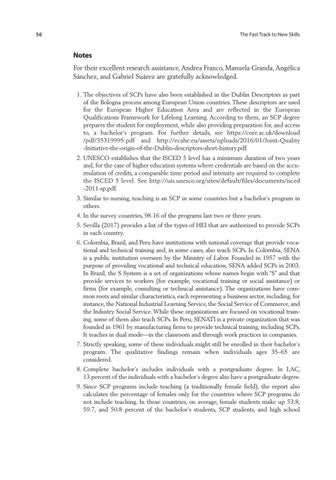56
The Fast Track to New Skills
Notes For their excellent research assistance, Andrea Franco, Manuela Granda, Angélica Sánchez, and Gabriel Suárez are gratefully acknowledged. 1. The objectives of SCPs have also been established in the Dublin Descriptors as part of the Bologna process among European Union countries. These descriptors are used for the European Higher Education Area and are reflected in the European Qualifications Framework for Lifelong Learning. According to them, an SCP degree prepares the student for employment, while also providing preparation for, and access to, a bachelor’s program. For further details, see https://core.ac.uk/download / pdf/35319995.pdf and http://ecahe.eu/assets/uploads/2016/01/Joint-Quality -Initiative-the-origin-of-the-Dublin-descriptors-short-history.pdf. 2. UNESCO establishes that the ISCED 5 level has a minimum duration of two years and, for the case of higher education systems where credentials are based on the accumulation of credits, a comparable time period and intensity are required to complete the ISCED 5 level. See http://uis.unesco.org/sites/default/files/documents/isced -2011-sp.pdf. 3. Similar to nursing, teaching is an SCP in some countries but a bachelor’s program in others. 4. In the survey countries, 98.16 of the programs last two or three years. 5. Sevilla (2017) provides a list of the types of HEI that are authorized to provide SCPs in each country. 6. Colombia, Brazil, and Peru have institutions with national coverage that provide vocational and technical training and, in some cases, also teach SCPs. In Colombia, SENA is a public institution overseen by the Ministry of Labor. Founded in 1957 with the purpose of providing vocational and technical education, SENA added SCPs in 2003. In Brazil, the S System is a set of organizations whose names begin with “S” and that provide services to workers (for example, vocational training or social assistance) or firms (for example, consulting or technical assistance). The organizations have common roots and similar characteristics, each representing a business sector, including, for instance, the National Industrial Learning Service, the Social Service of Commerce, and the Industry Social Service. While these organizations are focused on vocational training, some of them also teach SCPs. In Peru, SENATI is a private organization that was founded in 1961 by manufacturing firms to provide technical training, including SCPs. It teaches in dual mode—in the classroom and through work practices in companies. 7. Strictly speaking, some of these individuals might still be enrolled in their bachelor’s program. The qualitative findings remain when individuals ages 35–65 are considered. 8. Complete bachelor’s includes individuals with a postgraduate degree. In LAC, 13 percent of the individuals with a bachelor’s degree also have a postgraduate degree. 9. Since SCP programs include teaching (a traditionally female field), the report also calculates the percentage of females only for the countries where SCP programs do not include teaching. In those countries, on average, female students make up 53.8, 59.7, and 50.8 percent of the bachelor’s students, SCP students, and high school

